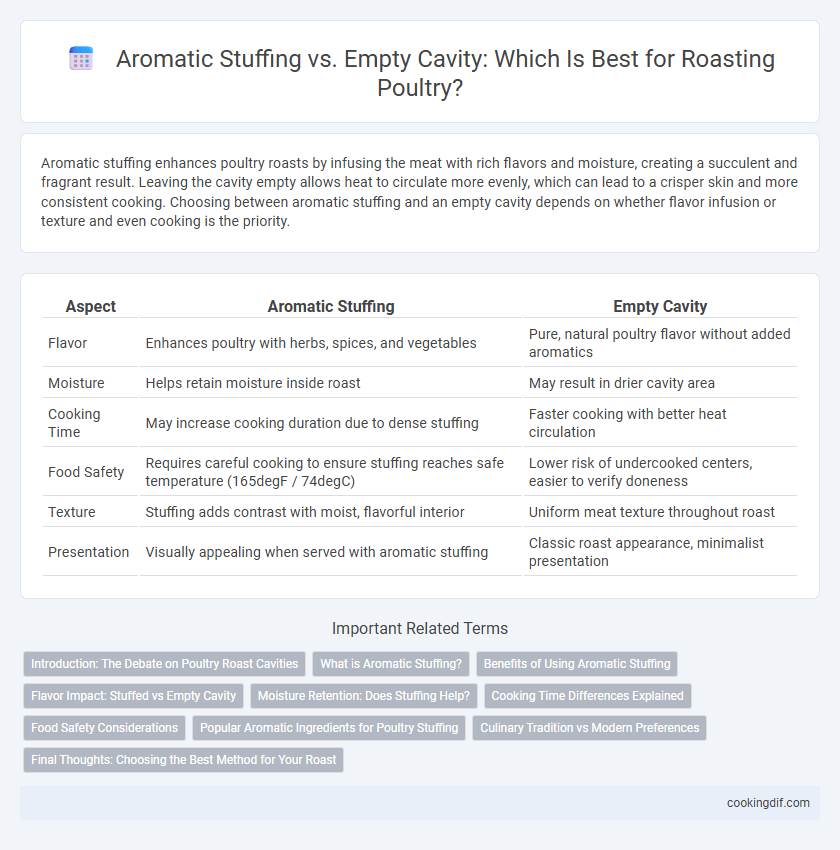Aromatic stuffing enhances poultry roasts by infusing the meat with rich flavors and moisture, creating a succulent and fragrant result. Leaving the cavity empty allows heat to circulate more evenly, which can lead to a crisper skin and more consistent cooking. Choosing between aromatic stuffing and an empty cavity depends on whether flavor infusion or texture and even cooking is the priority.
Table of Comparison
| Aspect | Aromatic Stuffing | Empty Cavity |
|---|---|---|
| Flavor | Enhances poultry with herbs, spices, and vegetables | Pure, natural poultry flavor without added aromatics |
| Moisture | Helps retain moisture inside roast | May result in drier cavity area |
| Cooking Time | May increase cooking duration due to dense stuffing | Faster cooking with better heat circulation |
| Food Safety | Requires careful cooking to ensure stuffing reaches safe temperature (165degF / 74degC) | Lower risk of undercooked centers, easier to verify doneness |
| Texture | Stuffing adds contrast with moist, flavorful interior | Uniform meat texture throughout roast |
| Presentation | Visually appealing when served with aromatic stuffing | Classic roast appearance, minimalist presentation |
Introduction: The Debate on Poultry Roast Cavities
Aromatic stuffing enhances poultry roasts by infusing herbs, spices, and aromatics directly into the meat, creating deeper, more complex flavors. In contrast, an empty cavity allows hot air to circulate freely, promoting even cooking and a crispier skin. Understanding the balance between flavor infusion and cooking efficiency is essential for achieving the perfect poultry roast.
What is Aromatic Stuffing?
Aromatic stuffing consists of a blend of herbs, spices, vegetables, and fruits placed inside poultry cavities to infuse moisture and rich flavors during roasting. Common ingredients include onions, garlic, celery, carrots, fresh herbs like thyme and rosemary, and citrus peels, which release fragrant oils that enhance the meat's natural taste. Using aromatic stuffing not only improves the poultry's juiciness but also creates a savory aroma that elevates the overall roasting experience.
Benefits of Using Aromatic Stuffing
Aromatic stuffing enhances poultry roasts by infusing flavors directly into the meat, creating a moist and well-rounded taste experience. Herbs, spices, and aromatics like garlic and onions release flavorful steam that penetrates the cavity, improving overall juiciness and aroma. This technique also adds visual appeal and complexity, making the roast more enticing and delicious.
Flavor Impact: Stuffed vs Empty Cavity
Aromatic stuffing inside a poultry roast infuses the meat with enhanced flavors as the herbs, spices, and vegetables release fragrant oils during cooking, penetrating the meat's interior for a more complex taste profile. In contrast, an empty cavity allows hot air to circulate freely, resulting in a crisper skin but a milder overall flavor since no additional aromatic compounds are introduced from within. Studies show that flavor compounds such as thyme, garlic, and citrus zest in stuffing can increase perceived juiciness and depth of flavor by up to 30% compared to unstuffed roasts.
Moisture Retention: Does Stuffing Help?
Aromatic stuffing can enhance moisture retention in poultry roasts by acting as a barrier that slows heat penetration, allowing the meat to stay juicier during cooking. Stuffing with herbs, vegetables, and broth releases steam inside the cavity, which helps maintain internal moisture levels. Leaving the cavity empty often results in faster drying, particularly in white meat, due to direct heat exposure and air circulation within the bird.
Cooking Time Differences Explained
Using aromatic stuffing in poultry roasts increases cooking time due to added density and moisture, requiring the heat to penetrate both the meat and the stuffing. An empty cavity allows for more even air circulation, leading to faster and more consistent cooking. Ensuring the poultry reaches a safe internal temperature of 165degF (74degC) is crucial regardless of stuffing presence, with stuffed birds often needing up to 30-45 minutes longer in the oven.
Food Safety Considerations
Using aromatic stuffing inside poultry roasts creates food safety risks due to uneven heat penetration, which can leave the stuffing undercooked and prone to bacterial contamination such as Salmonella. Cooking poultry and stuffing separately at proper temperatures ensures thorough heat distribution, minimizing cross-contamination and maintaining safe internal temperatures above 165degF (74degC). Ensuring the stuffing reaches the same safe internal temperature as the poultry meat is critical for preventing foodborne illnesses.
Popular Aromatic Ingredients for Poultry Stuffing
Popular aromatic ingredients for poultry stuffing include fresh herbs like rosemary, thyme, and sage, which impart robust, earthy flavors to the roast. Citrus zest from lemons or oranges adds a bright, tangy note that balances the richness of the meat, while garlic cloves and onion segments contribute depth and sweetness. Incorporating these aromatics into the cavity enhances moisture retention and infuses the poultry with complex, savory aromas during roasting.
Culinary Tradition vs Modern Preferences
Aromatic stuffing in poultry roasts enhances flavor complexity by infusing herbs, spices, and vegetables directly into the meat, a culinary tradition rooted in robust, rustic cooking methods. Modern preferences favor roasting with an empty cavity to ensure even heat circulation and crispier skin, prioritizing texture and simplicity over integrated flavors. Balancing these approaches reflects evolving tastes, where heritage aromatics meet contemporary techniques for optimal roasting results.
Final Thoughts: Choosing the Best Method for Your Roast
Aromatic stuffing infuses poultry roasts with enhanced flavors and moisture, creating a more complex taste profile. Roasting with an empty cavity ensures even heat distribution and reduces the risk of undercooked filler, preserving food safety. Choosing between aromatic stuffing and an empty cavity depends on flavor preference and cooking precision for optimal roast results.
Aromatic Stuffing vs Empty Cavity for Poultry Roasts Infographic

 cookingdif.com
cookingdif.com